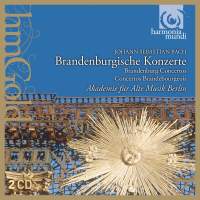Texte paru dans: / Appeared in: |
|
|
Outil de traduction (Très approximatif) |
|
|
Reviewer: Nicholas Anderson
When I reviewed the recording of Bach's four Orchestral Suites by this group (Harmonia Mundi, 8/96), I remarked that performances of the Brandenburgs by the ensemble must surely follow. Well , here they are - the first to enter Harmonia Mundi's catalogue. What I enjoyed about the recording of the Suites was a rhythmic vitality , a tasteful feeling for ornament and an appropriate sense of occasion, intimate in the case of the B minor Suite, festive and ceremonial in the case of the other three.
The Berlin Academy's new recording of the Brandenburgs shares these qualities, though I was not always content with tuning in the First and Second Concertos of the set. In the First Concerto the two horns make a splendidly robust, grainy sound, though rhythmically the opening bars of the initial movement seemed a little stiff. The Adagio which follows it, however, is more relaxed and moves with an elegantly phrased fluency. The third movement Allegro has a pleasingly light tread, though in bar 13 there is an intrusive noise, possibly caused by a music stand being struck. Whatever it is, it ought not to be there. The tempos of the menuets and trios seem almost ideal, somewhat slower than some recent performances and consequently preserving much of their inherent balletic grace.
Trumpeter Friedemann Immer must have made at least half-a-dozen recordings of the Second Brandenburg . I have not always enjoyed his playing and have found his random omission of Bach's ornaments unwarranted. The present performance should rank among his strongest, though, since he negotiates with commendable security most of this challenging music without sacrificing the ornaments. The other elements of the concertino are secure , providing a freely but tastefully ornamented middle movement. The Third Concerto is lively and lightly articulated throughout, but ( didn't much care for the rambling harpsichord solo between the two Allegros, which struck me as stylistically questionable and too loose to be effective.
The Fourth Concerto is a lively affair, crisply articulated and rhythmically buoyant. The violin solos are given plenty of shape and space to breathe, while the two recorders are chirpy and well defined if, on occasion, prey to excessive nights of
|
|
|
|
|
|
Cliquez l'un ou l'autre
bouton pour découvrir bien d'autres critiques de CD |
|




